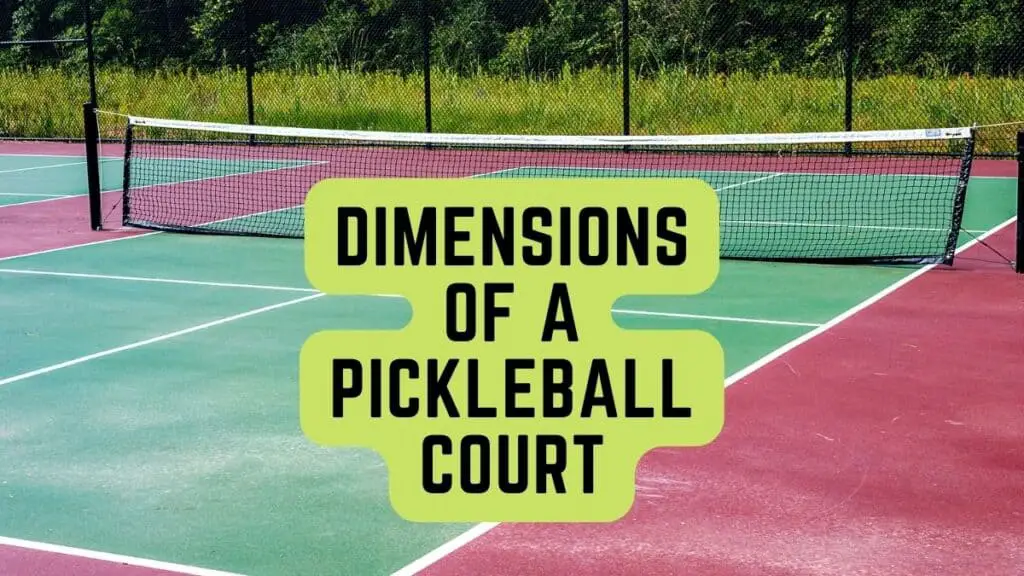If you’re thinking of building a pickleball court outside a recreation center or school, you must know the exact dimensions of the court as well as other technicalities, such as the net height and the total play area.
A pickleball court is rectangular with dimensions of 20 feet by 44 feet, including the lines for both singles and doubles play. The court is divided into two halves by a line that runs through the center of the net. Each half of the court is 21 feet by 22 feet.
The size of a pickleball court is about the same as a doubles badminton court. The minimum recommended dimensions of a pickleball court are 30 by 60 feet, which is one-fourth the size of a standard tennis court.
In this article, we will find out if it’s possible to make your own pickleball court and explore other details that go into constructing this type of court for recreational and league play.

Can You Make Your Own Pickleball Court?
One of the great things about pickleball is that it can be played on any type of court, including your own backyard court. In fact, many people convert their backyard space into a pickleball court and start playing. All you need is a flat, level surface and some basic materials. The court can be made from any material, but concrete is the most popular choice.
Once you have measured the entire area available for building the court, you will need to mark the dimensions. Using chalk, measure 44 feet lengthwise and 20 feet widthwise and mark these as the court’s outer boundaries.
The net should be placed in the middle of the court and secured at the edges. The net’s height should be 36 inches at the sideline and 34 inches at the center. At both sides of the net, you have to draw the line at 7 feet to mark the kitchen or non-volley zone.
The remaining 15 feet on both sides are dedicated as service areas. A center line divides this area to mark the right and left service sides. Each service side is 10 feet wide and 15 feet long.
How to Build an Outdoor Pickleball Court?
So, you have decided to build a temporary pickleball court in your backyard. What is the next step, and how to do it professionally?
The first step is to get a professional court layout, so you don’t miss out on anything. You can download your own printable layout of a pickleball court from the USA Pickleball official website. This layout will also tell you about line tolerances as well as a description of each term used in the court layout diagram.
Here are a few important terms to know;
Baselines
Baselines refer to the boundaries of a pickleball court parallel to the net. One player serves the ball from within the baseline to start the game. The ball must be served diagonally into the opponent’s service court.
Sidelines
Sidelines run perpendicular to the net and are used to determine if a player is in or out of bounds. This is the outside boundary of the court.
Non-volley zone (NVZ)
The non-volley zone on a pickleball court is the area on both sides of the net, extending 7 feet. This area is also known as the “kitchen.” Pickleball players must not volley the ball while they are in the kitchen. If they do, they will lose the point.
Read more here: What is the Kitchen in Pickleball?
Non-volley line
The line that runs parallel to the net 7 feet on either side is known as the non-volley line. Players must take precautions to avoid standing on this line or crossing it while volleying the ball. All lines on the court are about 2 inches wide and are marked by white tape.
Centerline
The centerline divides the court into two halves, from the baselines to the non-volley zones. This line is particularly useful for doubles play and marks the right and left service areas. The service areas are each 10 feet wide.
Service area
The service area is located on either side of the centerline, including the 2-inch wide centerline, sideline, and baseline.
Although the lines are considered part of the court, and a ball is ruled inbounds if it lands on one of these lines, the standard rule is to see where it touches the ground. If it touches the ground outside the boundary and bounces back in, the shot will still be considered out of bounds.
If you’re building an outdoor court, you must ensure the land is flat and level. If it’s not already leveled, you will have to use concrete or other materials to flatten it and then mark the boundaries.
How to Construct an Indoor Pickleball Court?
An indoor pickleball court’s dimensions and space requirements are the same as an outdoor court. You can use the same layout to construct the outer boundaries of the court and mark the lines using chalk, tape, or paint. Make sure each line is about 2 inches wide.
You can also try different flooring options for your indoor courts, such as wood, carpet, or rubberized floor. For outdoor courts, concrete and asphalt are recommended options. The grass is not a practical choice because the ball will not bounce as ideally as it would on a hard surface.
For indoor and outdoor courts, you have to make sure there is a minimum of 30 feet by 60 feet area available for play. This space is required to build the court’s boundaries, allow for line tolerances, and have some extra space available to define out-of-bounds shots.
The net should stretch from post to post at least 21 feet 9 inches long. The posts should not be more than 3 inches in diameter. Once the net has been stretched, the height should be 36 inches at the sidelines. Its edge should be covered with a 2-inch wide white tape to measure its exact height.



